Key Takeaways
- Harness the Power of LinkedIn: Utilize LinkedIn’s vast professional network to connect with top talent across industries and geographies, presenting your organization as an attractive employer.
- Build an Authentic Employer Brand: Showcase your company’s unique culture, success stories, and growth opportunities to resonate with ambitious candidates and establish your employer brand.
- Proactive Candidate Sourcing: Engage in active candidate sourcing through personalized InMail messages, advanced search filters, and talent communities to connect with potential candidates proactively.
In the fast-paced and ever-evolving landscape of the modern business world, the success of any organization hinges on the quality of its talent.
As the old adage goes, “Your people are your greatest asset,” and finding the right individuals to join your team can be a transformative game-changer.
However, in a sea of countless recruitment platforms and digital job boards, how can you ensure that you attract, engage, and hire the top-notch candidates your company truly deserves?
Enter LinkedIn, the unparalleled professional networking platform that has revolutionized the way businesses connect with talent.
LinkedIn has grown far beyond its origins as a virtual resume repository; it has become a dynamic ecosystem where professionals from all industries converge, engage, and thrive.
When harnessed to its fullest potential, LinkedIn can serve as your most powerful ally in building a dream team that will propel your organization to new heights.
In this comprehensive and innovative guide, we delve into the art and science of leveraging LinkedIn to hire top talent.
Whether you are an experienced recruiter seeking to refine your strategies or a business owner on a quest to expand your workforce, this blog is your compass to navigate the vast possibilities offered by this social media titan.
Why LinkedIn, you may wonder?
The answer lies in its unparalleled reach and depth.
With over 930 million active users worldwide and counting, LinkedIn has emerged as the de facto digital meeting ground for professionals of all calibers, experiences, and aspirations.
From seasoned executives to budding entrepreneurs, from creative artisans to tech-savvy engineers – LinkedIn hosts a thriving ecosystem of talent just waiting to be discovered.
However, let us be candid: LinkedIn, with its array of features and seemingly infinite possibilities, can be a labyrinthine maze for the uninitiated.
Fear not, though, for as we traverse this terrain together, we will unravel the mysteries and unlock the full potential of this platform for your hiring needs.
Are you ready to embark on a transformative journey where you will learn to create an irresistible employer brand, craft captivating job posts, and engage with top-tier candidates?
Get ready to tap into LinkedIn’s treasure trove of search and filtering tools, delve into the art of personalized candidate outreach, and measure your hiring success with precision.
In the chapters that follow, we’ll equip you with time-tested best practices, insider tips, and creative techniques that will set you apart from the competition.
Whether you’re a seasoned LinkedIn expert or a relative newcomer, our goal is to empower you with the knowledge and confidence to navigate LinkedIn’s terrain like a seasoned explorer.
Picture a future where your company’s LinkedIn presence shines like a beacon, attracting talent from all corners of the digital realm.
Imagine forging connections with top-tier professionals who align perfectly with your company’s vision and values. Envision building long-term relationships with passive candidates who were once elusive, but now stand eager to join your ranks.
The power to shape this future lies within your grasp, and we are here to light the way.
So, fasten your seatbelts and brace yourself for an exhilarating journey through the wonders of LinkedIn talent acquisition.
Let’s transform your hiring process and uncover a world of untapped potential – because when you harness the full power of LinkedIn, hiring top talent is not just a dream; it becomes your organization’s reality.
Let’s dive in and unleash the true potential of your hiring endeavors on LinkedIn.
Before we venture further into this article, we like to share who we are and what we do.
About 9cv9
9cv9 is a business tech startup based in Singapore and Asia, with a strong presence all over the world.
With over six years of startup and business experience, and being highly involved in connecting with thousands of companies and startups, the 9cv9 team has listed some important learning points in this overview of the guide on How to Hire Top Talent Using LinkedIn.
If your company needs recruitment and headhunting services to hire top-quality employees, you can use 9cv9 headhunting and recruitment services to hire top talents and candidates. Find out more here, or send over an email to [email protected].
Or just post 1 free job posting here at 9cv9 Hiring Portal in under 10 minutes.
How to Hire Top Talent Using LinkedIn
- Optimizing Your LinkedIn Company Page for Attracting Talent
- Creating Irresistible Job Posts on LinkedIn
- Leveraging LinkedIn’s Search and Filtering Tools
- Building a Strong Employer Brand on LinkedIn
- Proactively Sourcing Candidates on LinkedIn
- Nurturing Relationships with Passive Candidates
- Showcasing Your Company’s Growth and Success
- Measuring Success: Key Metrics for LinkedIn Hiring Campaigns
- Overcoming Challenges and Best Practices for LinkedIn Hiring
1. Optimizing Your LinkedIn Company Page for Attracting Talent
In today’s competitive job market, a strong employer brand is essential to attract top talent.
Your LinkedIn Company Page serves as the virtual front door to your organization, and optimizing it can significantly impact your ability to attract and engage with potential candidates.
Read more on our in-depth guide on “A Comprehensive Guide to Optimizing Your Employer Branding on Your LinkedIn Page” to learn how to optimize your Employer Branding on the LinkedIn Page.
In this section, we will explore proven strategies and best practices to optimize your LinkedIn Company Page, transforming it into a magnet for top-tier talent.
- Craft a Compelling Company Profile:
Your Company Profile is the first thing potential candidates see when they visit your page.
It should be engaging, informative, and reflective of your company culture and values.
According to LinkedIn’s research, Company Pages with a complete profile get 30% more weekly views.
So, ensure your profile includes:
- A visually appealing and high-resolution company banner that showcases your brand identity and values.
- An attention-grabbing company description that highlights your mission, vision, and unique selling propositions.
- A detailed overview of your company’s history, milestones, and accomplishments, providing candidates with a sense of your journey and growth.
Example: Take inspiration from IBM’s Company Page, where their simple and minimalist banner reflects their innovative and direct mindset, and their concise yet impactful description emphasizes their commitment to transforming industries through groundbreaking solutions.
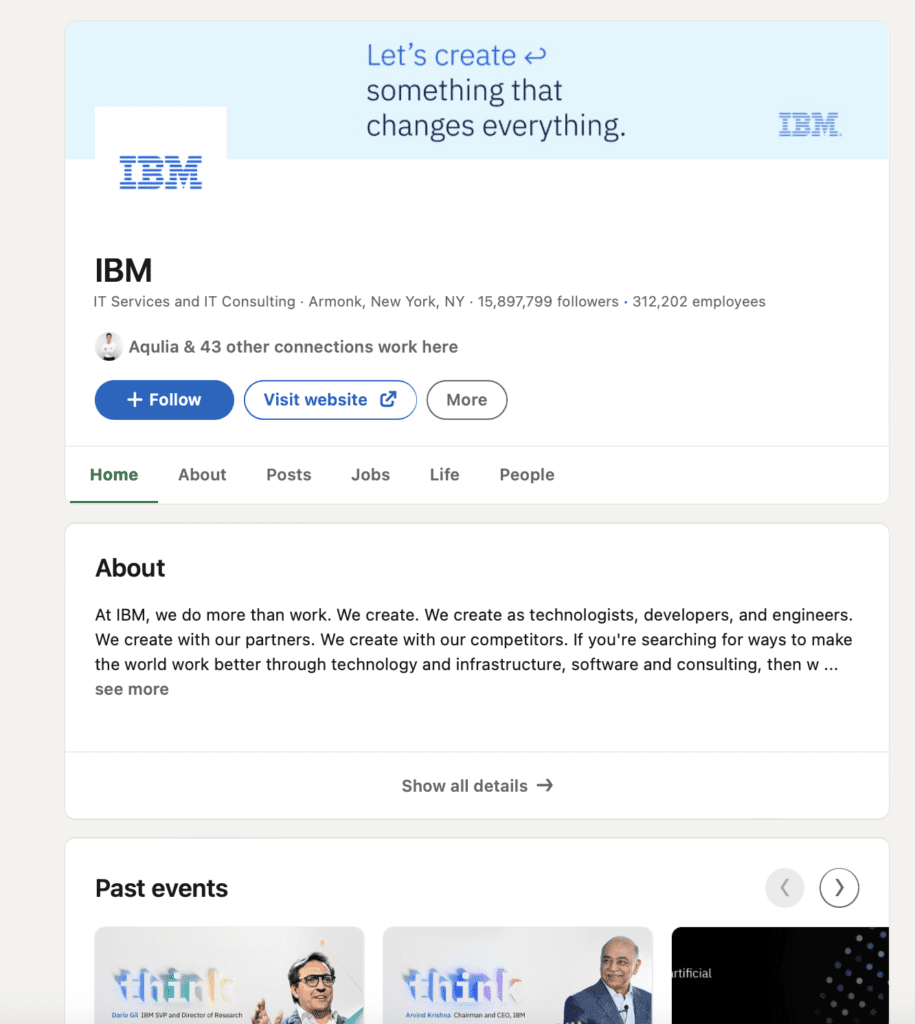
- Showcase Your Company Culture and Values:
Candidates seek more than just a job; they want to align themselves with a company whose values resonate with their own.
According to a LinkedIn survey, 70% of professionals would not work at a leading company if it had a bad reputation.
So, ensure your Company Page showcases your company culture and values by:
- Sharing employee testimonials and success stories that highlight the positive experiences of working in your organization.
- Incorporating photos and videos of team members collaborating, celebrating achievements, and participating in corporate social responsibility initiatives.
Example: Check out Google’s Company Page, where they consistently highlight their employee-centric culture through behind-the-scenes photos, videos of team events, and inspiring employee stories that emphasize their commitment to creating a diverse and inclusive work environment.
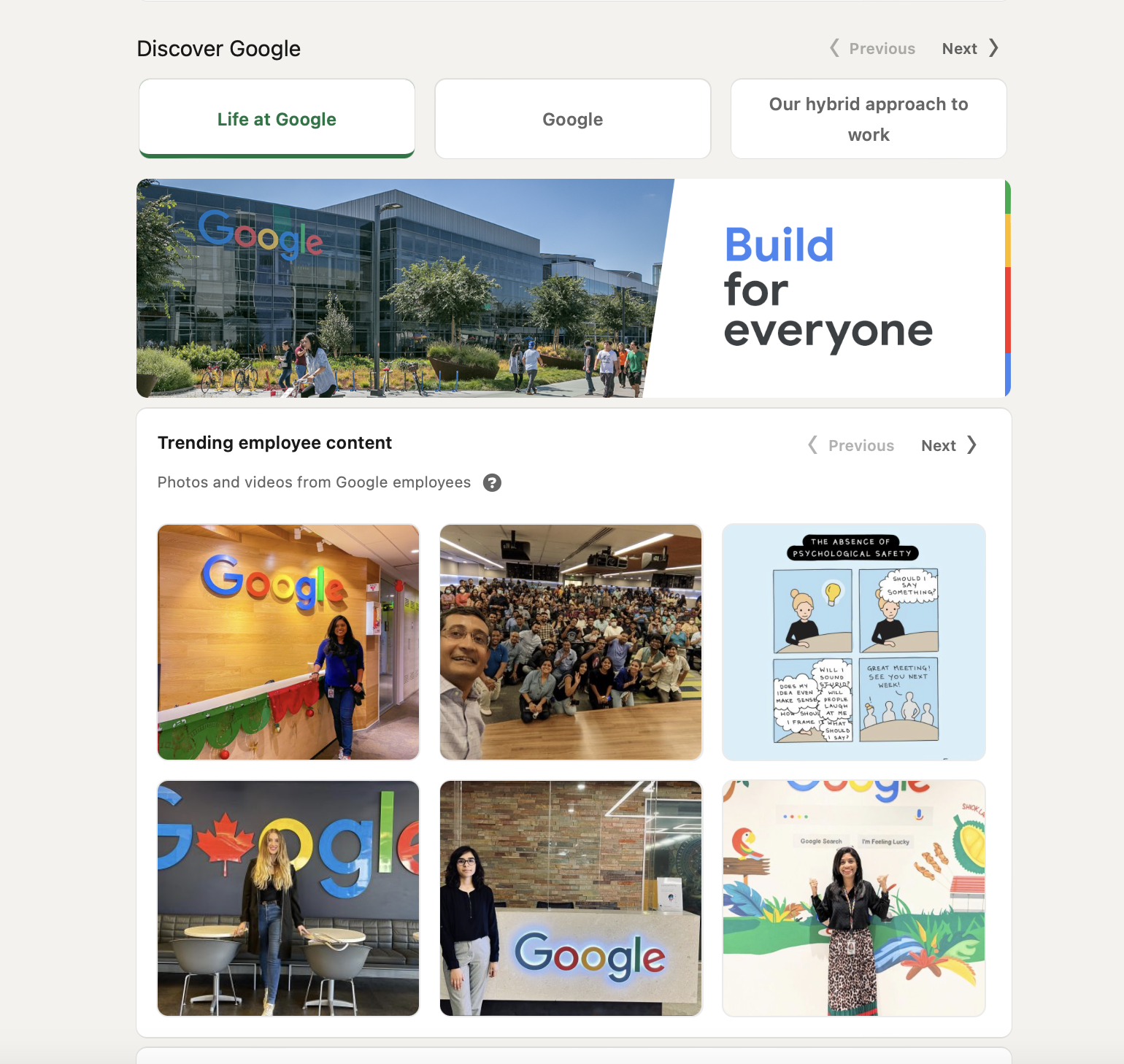
- Highlight Employee Testimonials and Success Stories:
The power of employee advocacy cannot be overstated.
Prospective candidates are more likely to trust the experiences of current employees.
Leverage your Company Page to:
- Feature regular employee spotlights and testimonials, showcasing the diverse talents and backgrounds of your team members.
- Encourage employees to share their experiences on their personal LinkedIn profiles, amplifying your employer brand to their networks.
Example: HubSpot’s Company Page regularly spotlights team members from various departments, sharing their achievements and insights. Additionally, they encourage employees to share their experiences using the hashtag #lifeathubspot, creating a strong sense of community and authenticity.
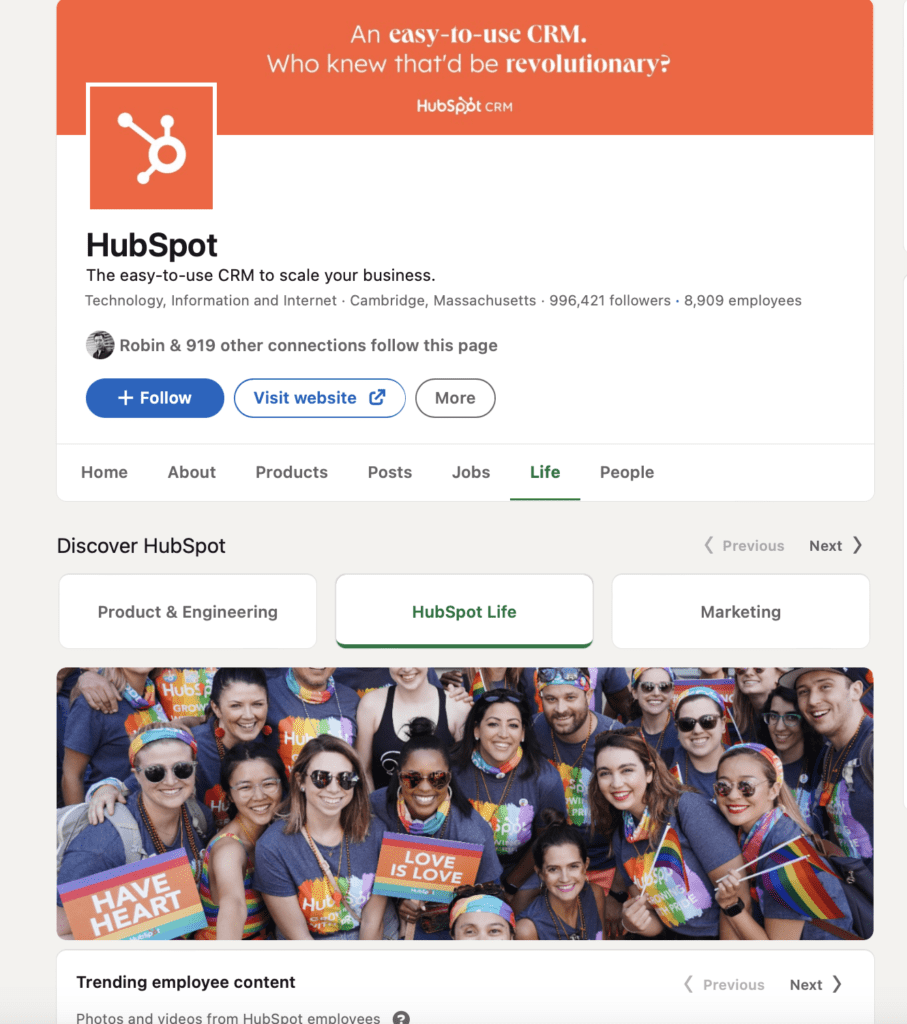
- Leverage Native Video Content:
Create and share videos that offer a glimpse into your company’s culture, projects, and day-to-day life to pique the interest of potential candidates.
Example: Salesforce, a leader in cloud-based solutions, effectively uses native video to showcase their employees talking about their roles and experiences, as well as sharing insights on the company’s culture and impact on the community.
- Engage in Thought Leadership:
Position your company as a thought leader in your industry by sharing valuable and insightful content on your Company Page.
Publish articles, thought pieces, and industry-specific content that will not only attract potential candidates but also demonstrate your expertise to clients and partners.
Example: Microsoft’s Company Page frequently shares articles and posts authored by their employees, covering a wide range of topics from technology trends to diversity and inclusion initiatives.
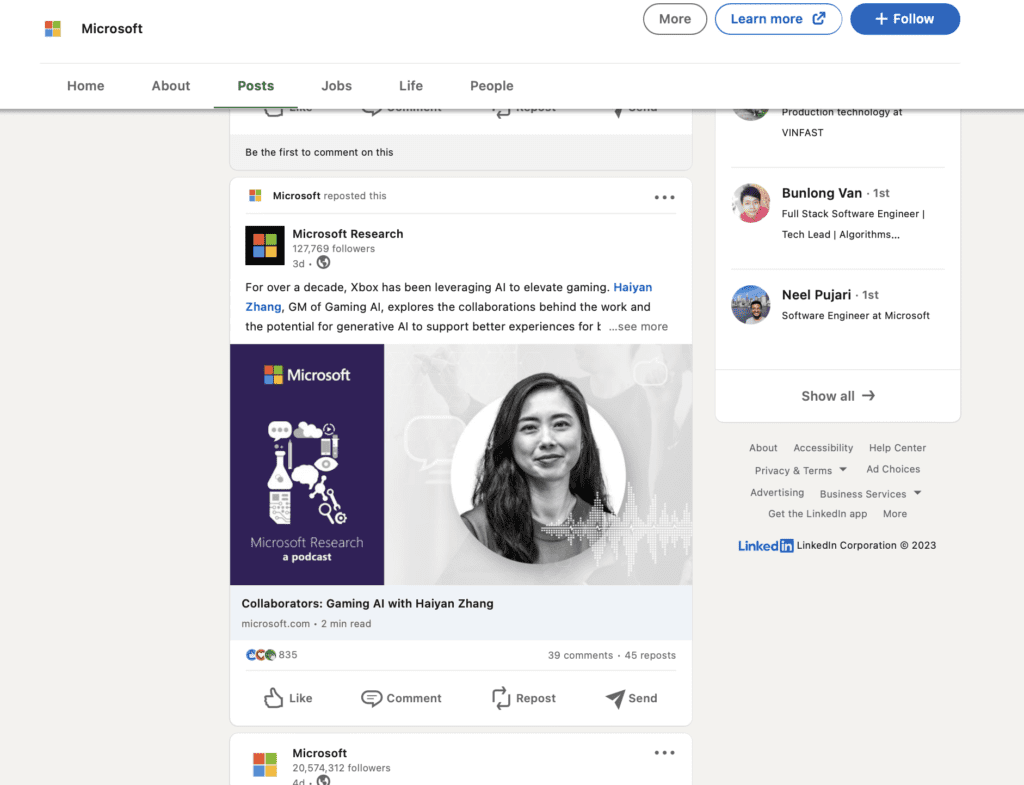
By following these strategies and investing time and effort into optimizing your LinkedIn Company Page, you can create a powerful employer brand that attracts and retains top talent.
Remember, in today’s digital age, your online presence speaks volumes about your company’s values and culture, making it crucial to showcase your organization as an employer of choice.
Stay consistent, authentic, and proactive in your engagement, and you’ll undoubtedly see the rewards in the form of highly qualified candidates eager to join your team.
2. Creating Irresistible Job Posts on LinkedIn
Crafting compelling and irresistible job posts on LinkedIn is essential to capturing the attention of top talent in a competitive job market.
Your job post is the first point of contact with potential candidates, and it must stand out amidst a sea of other opportunities.
In this section, we will delve into the art of creating job posts that not only attract candidates but also compel them to apply, ensuring you find the perfect match for your open positions.
- Write Clear and Engaging Job Titles:
The job title is the first thing candidates see, and it plays a crucial role in enticing them to click and learn more about the opportunity.
According to LinkedIn’s internal data, shorter job posts receive 8.4% more applications per view than average. Avoid generic titles and be specific about the role and level you are hiring for.
Example: Weak: “Marketing Manager Needed” Strong: “Digital Marketing Manager | Driving Growth and Innovation | Fast-Growing Tech Startup”
The strong job title not only specifies the role but also highlights the company’s attributes and potential growth opportunities, making it more appealing to potential candidates.
Read more on how to craft a strong Job Title in our guide “Job Titles that Stand Out: A Guide to Candidate Attraction“.
- Craft a Captivating Job Description:
A well-written job description is the foundation of a successful job post.
It should provide a clear overview of the role, responsibilities, and qualifications required.
Use concise and engaging language that showcases your company’s unique selling propositions and the exciting challenges that come with the position.
Example: Weak: “We are looking for a software developer with experience in Java and Python.” Strong: “Join our dynamic team of software wizards and shape the future of technology! As a software developer, you’ll spearhead cutting-edge projects, utilizing your expertise in Java and Python to create innovative solutions that impact millions worldwide.”
The strong job description paints a vivid picture of the role’s impact and the exciting projects the candidate would work on, making it more enticing.
Also, read more on how to write top job descriptions in our guide here “Mastering the Art of Writing Effective Job Descriptions: A Comprehensive Guide“.
In addition, have a sneak peek at our guide “How to Write Job Responsibilities that Attract Top Talent” to learn how to attract top talents with strong job responsibilities written.
- Incorporate Relevant Keywords and Skills:
To ensure your job post reaches the right candidates, include relevant keywords and essential skills in your description.
Use industry-specific terms and phrases that resonate with professionals in your target field. According to a survey by Jobvite, 92% of recruiters use social media, including LinkedIn, to find high-quality candidates.
Example: Weak: “Seeking a Project Manager with experience in project planning and execution.” Strong: “We are seeking an experienced Project Manager skilled in Agile methodologies, risk management, and cross-functional team leadership.”
The strong job post incorporates specific keywords like “Agile methodologies” and “cross-functional team leadership,” ensuring it attracts candidates with the desired skill set.
Read more on how to use keywords to hire better here in this guide “Unlocking the Power of Keyword Research for Successful Hiring Strategies“.
- Highlight Company Culture and Benefits:
In today’s job market, candidates seek more than just a paycheck; they desire a positive work culture and meaningful benefits.
According to a Glassdoor survey, 86% of employees and job seekers research company reviews and ratings to decide on where to apply for a job.
So, showcase your company’s unique culture and perks to attract top talent.
Example: Weak: “Competitive salary and benefits offered.” Strong: “Join our close-knit family of innovators and enjoy flexible work hours, ongoing professional development, and a collaborative work environment.”
The strong job post emphasizes the company’s culture and benefits, making it more appealing to potential candidates seeking a supportive and inclusive workplace.
- Use Multimedia to Engage Candidates:
Enhance your job post with multimedia elements like images, videos, and infographics to make it visually appealing and engaging.
According to LinkedIn, job posts with visuals receive up to 36% more candidate applications.
Example: Include a video showcasing employees talking about their experiences in the company and why it’s a great place to work.
- Provide a Clear Call-to-Action (CTA):
Encourage candidates to take action by providing a clear CTA at the end of your job post.
Let them know how to apply, whether it’s through a direct link, email, or the LinkedIn Easy Apply feature.
Example: “Ready to embark on this exciting journey with us? Apply now through the link below or reach out to our HR team at [email protected]”
By following these strategies and incorporating creative and informative elements, your job posts on LinkedIn will not only attract a higher quantity of candidates but also a higher quality of applicants who are genuinely excited about joining your organization.
Remember, the key is to be authentic, highlight your company’s unique value proposition, and demonstrate why your workplace is the perfect fit for ambitious and talented professionals.
3. Leveraging LinkedIn’s Search and Filtering Tools
LinkedIn’s powerful search and filtering tools are a treasure trove for recruiters and hiring managers seeking to find the perfect candidates for their open positions. With over 930 million active users, LinkedIn offers an extensive pool of talent across various industries and roles.
In this section, we will explore how to leverage LinkedIn’s search and filtering tools effectively, uncovering hidden gems and streamlining your candidate sourcing process.
- Utilize Advanced Search Filters to Find Ideal Candidates:
LinkedIn’s advanced search filters enable you to narrow down your candidate search based on specific criteria, such as location, industry, job title, education, and years of experience.
Example: Suppose you’re looking for a Senior Data Scientist with a Ph.D. in Computer Science and at least five years of experience. You can use the advanced search filters to refine your search and find candidates who meet these specific qualifications.
- Maximize the Power of Boolean Search Operators:
Boolean search operators allow you to create more complex and precise search queries. By combining keywords with operators such as “AND,” “OR,” and “NOT,” you can further fine-tune your candidate search.
Example: Suppose you’re hiring for a Content Marketing Manager. You can use Boolean operators to search for candidates with expertise in both “content marketing” AND “SEO” to find individuals who possess the desired skill set.
- Leverage LinkedIn’s Talent Insights for Informed Decisions:
LinkedIn’s Talent Insights provides valuable data and analytics to help you make data-driven hiring decisions. It offers real-time data on job market trends, competitor insights, and talent pools.
According to LinkedIn, companies using Talent Insights experience a reduction in time-to-hire.
Example: Suppose your company is expanding into a new location and needs to assess the talent landscape. By using Talent Insights, you can gather data on the availability of talent in that area, the skills in high demand, and competitor hiring trends to strategize your recruitment approach effectively.
- Navigating LinkedIn Recruiter for Advanced Candidate Sourcing:
LinkedIn Recruiter is a premium tool that offers additional functionalities for candidate sourcing.
With LinkedIn Recruiter, you can send personalized InMail messages to potential candidates and access more extensive search results.
Example: Suppose you’re targeting passive candidates for a senior executive position. With LinkedIn Recruiter, you can access a broader talent pool, send personalized InMail messages, and engage with potential candidates who may not actively be seeking new opportunities.
- Use Saved Searches to Stay Updated:
Once you’ve created a targeted search, save it to receive regular updates on new candidates who meet your criteria.
Saved searches allow you to stay proactive in your candidate sourcing efforts and never miss out on potential matches.
Example: Suppose you are continuously recruiting for software engineers with specific programming skills. By saving your search, you will receive notifications whenever new candidates with the desired qualifications join LinkedIn, ensuring you’re always on top of your hiring game.
- Monitor the “Open to Work” Feature:
LinkedIn offers an “Open to Work” feature that allows candidates to indicate their job-seeking status on their profiles.
Keep an eye out for this indicator, as it can help you identify candidates who are actively seeking opportunities.
Example: If you’re urgently looking to fill a position, focus your search on candidates who have enabled the “Open to Work” feature. These candidates are more likely to be responsive and actively pursuing new job opportunities.
By effectively leveraging LinkedIn’s search and filtering tools, you can expedite your candidate sourcing process, identify high-quality talent, and streamline your hiring efforts.
Stay informed about the latest updates and features on LinkedIn, as the platform continually evolves to enhance the recruitment experience for employers and job seekers alike.
Remember, the key to successful talent acquisition on LinkedIn lies in being proactive, precise, and data-driven in your approach.
4. Building a Strong Employer Brand on LinkedIn
In today’s competitive job market, building a strong employer brand on LinkedIn is paramount to attract and retain top talent.
A compelling employer brand not only helps you stand out among competitors but also establishes trust and credibility with potential candidates.
According to LinkedIn’s research, 72% of recruiting leaders worldwide agree that employer brand has a significant impact on hiring success.
In this section, we will explore the key strategies and best practices for crafting a powerful employer brand on LinkedIn, backed by relevant data and examples.
- Establish an Authentic and Trustworthy Brand Voice:
Authenticity is the foundation of a strong employer brand. Be genuine in your communication and showcase the unique aspects of your company culture.
According to an article, job seekers say that authenticity is essential when deciding which companies to support or work for.
Example: Virgin Group, led by Sir Richard Branson, exemplifies authenticity through their LinkedIn content. They share stories that highlight their adventurous and innovative company culture, giving potential candidates a glimpse of what it’s like to be a part of their team.
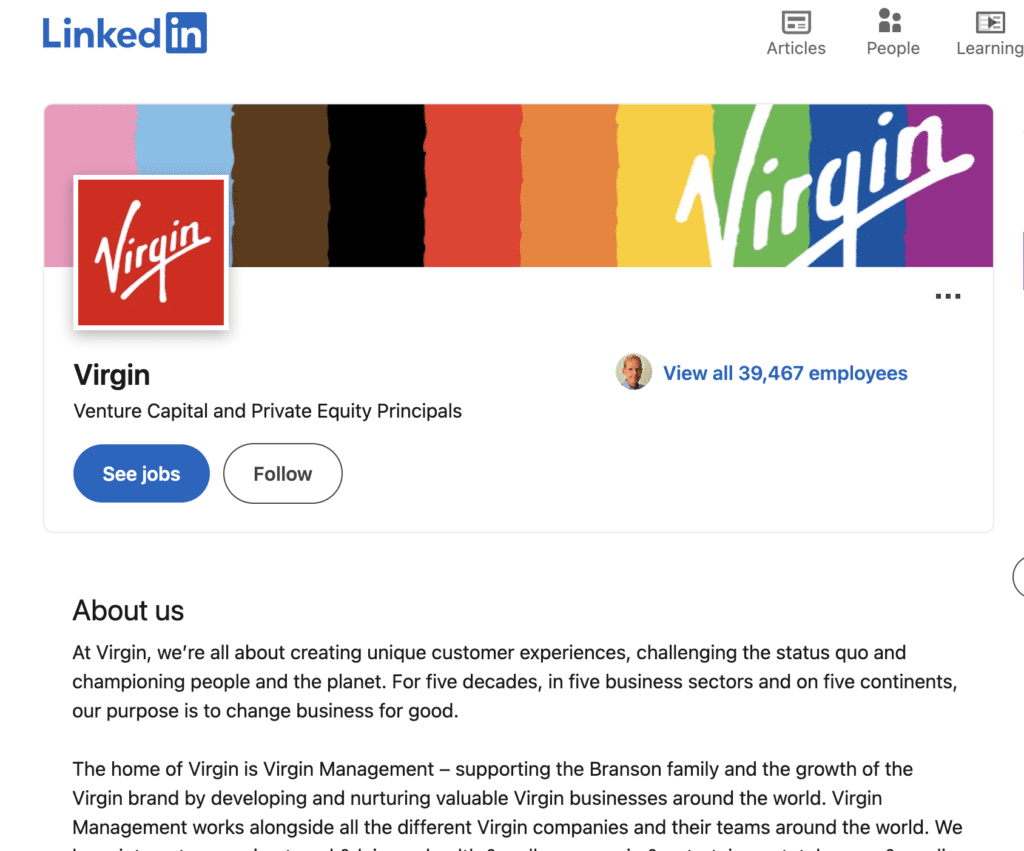
- Engage with Your LinkedIn Community and Followers:
Building a strong employer brand involves fostering engagement with your LinkedIn community and followers.
Regularly share meaningful content, respond to comments, and participate in discussions to create a sense of community around your brand.
Example: General Electric (GE) has a vibrant LinkedIn presence that engages its followers with thought-provoking content related to engineering, technology, and innovation. Their active involvement in conversations showcases their commitment to staying connected with their audience.
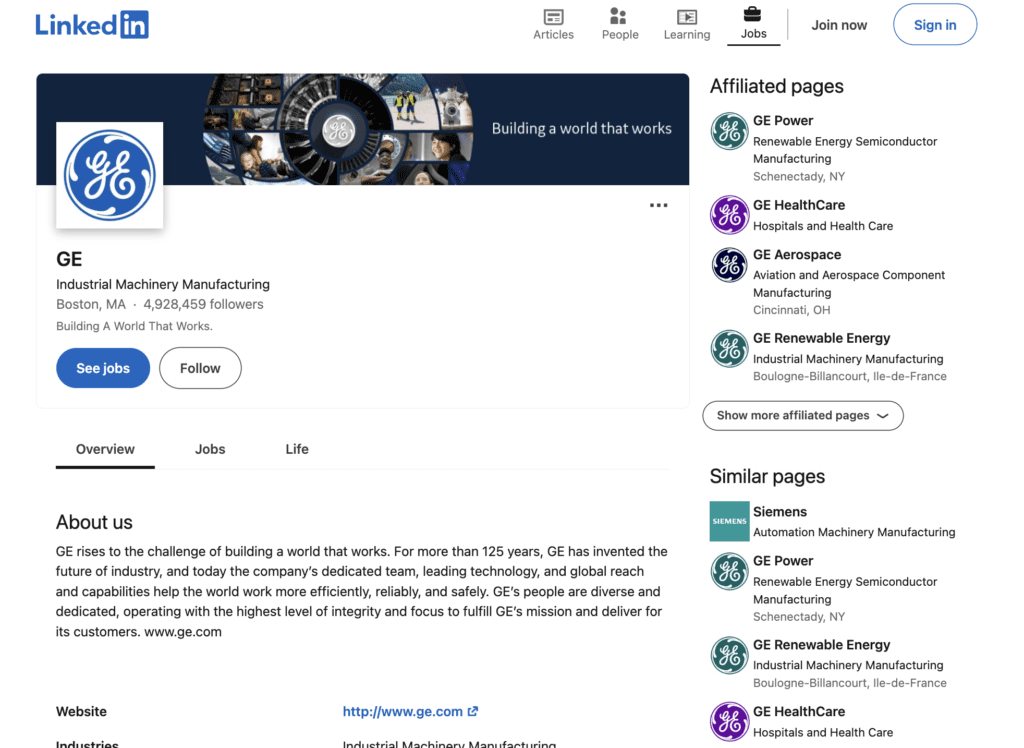
- Leverage LinkedIn’s Publishing Platform for Thought Leadership:
Position your company as a thought leader in your industry by sharing valuable content on LinkedIn’s publishing platform. According to LinkedIn, thought-leader ads had a 1.7x higher click-through rate and a 1.6x higher engagement rate.
Example: Microsoft’s LinkedIn page is a prime example of thought leadership. They publish articles covering diverse topics such as AI, cybersecurity, and digital transformation, showcasing their expertise and staying ahead in the technology landscape.
- Highlight Employee Experiences and Success Stories:
Your employees are your best brand advocates. Share their success stories and experiences working at your company to humanize your brand and attract potential candidates.
According to an article, content shared by employees receives 8x more engagement.
Example: Cisco regularly features employee stories on their LinkedIn page, showcasing the impact their employees make on the world through innovative technologies. This highlights Cisco as an employer that values its employees and provides opportunities for growth.
- Showcase Career Growth and Development Opportunities:
Job seekers are increasingly seeking opportunities for growth and development in their careers.
Use your LinkedIn Company Page to highlight career progression, learning opportunities, and mentoring programs available within your organization.
Example: Deloitte’s LinkedIn page emphasizes career growth by sharing stories of employees who have progressed from entry-level positions to leadership roles. This showcases Deloitte as an employer that invests in its employees’ professional development.
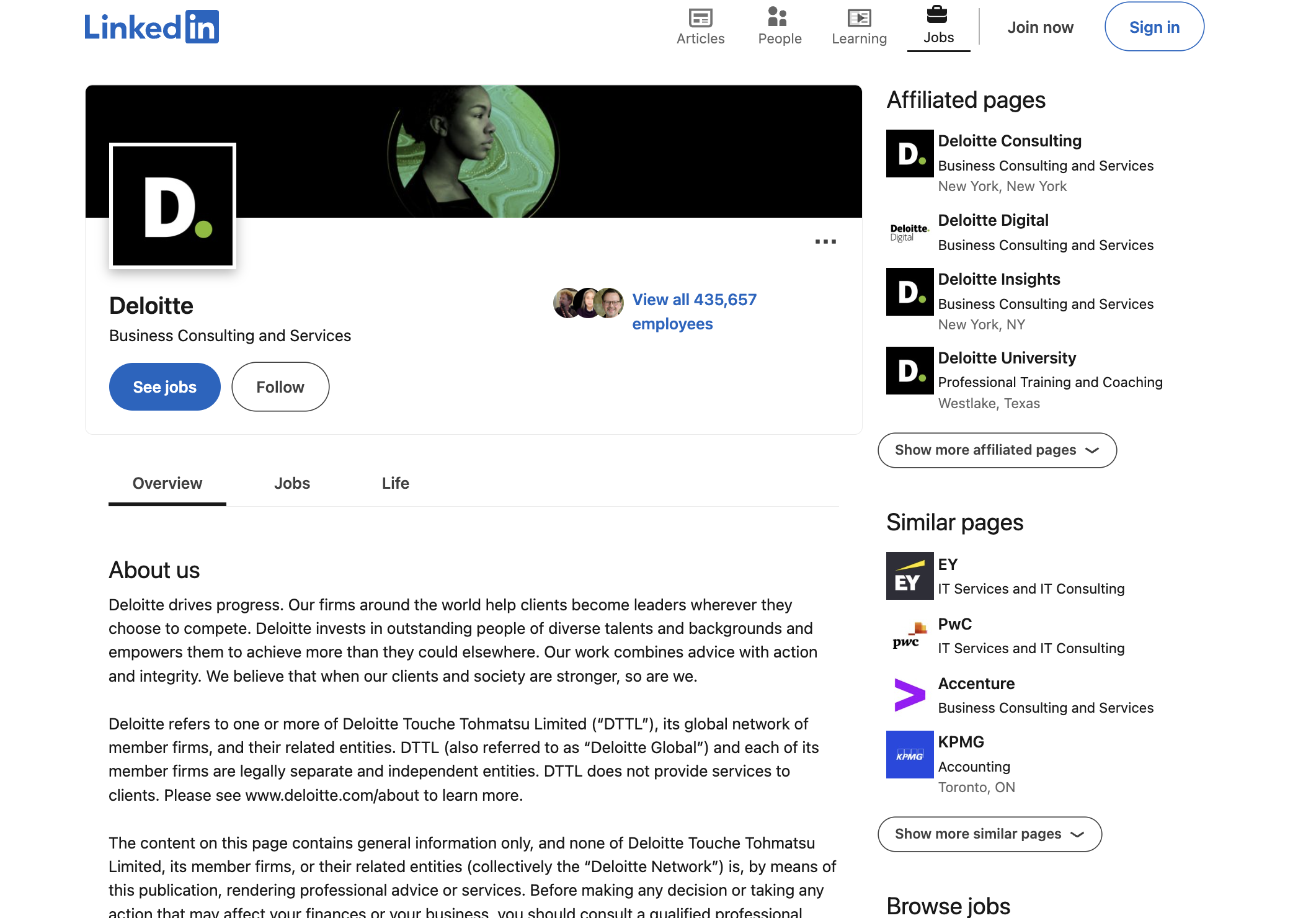
- Utilize LinkedIn’s Showcase Pages for Subsidiaries or Specialized Divisions:
If your company has multiple subsidiaries or specialized divisions, consider creating Showcase Pages on LinkedIn to cater to specific audiences.
This allows you to tailor your employer branding efforts to suit the unique attributes of each division.
Example: IBM utilizes Showcase Pages to highlight different aspects of its business, such as AI, cloud computing, and cybersecurity. This approach enables them to cater their messaging to specific audiences and establish expertise in each domain.
- Promote Employee Diversity and Inclusion Initiatives:
Diversity and inclusion have become crucial factors for job seekers when evaluating potential employers. Use LinkedIn to showcase your company’s commitment to fostering a diverse and inclusive workplace.
Example: Accenture’s LinkedIn page is dedicated to showcasing their initiatives and events focused on diversity and inclusion. They also share stories about employees from diverse backgrounds, demonstrating their dedication to creating an inclusive work environment.
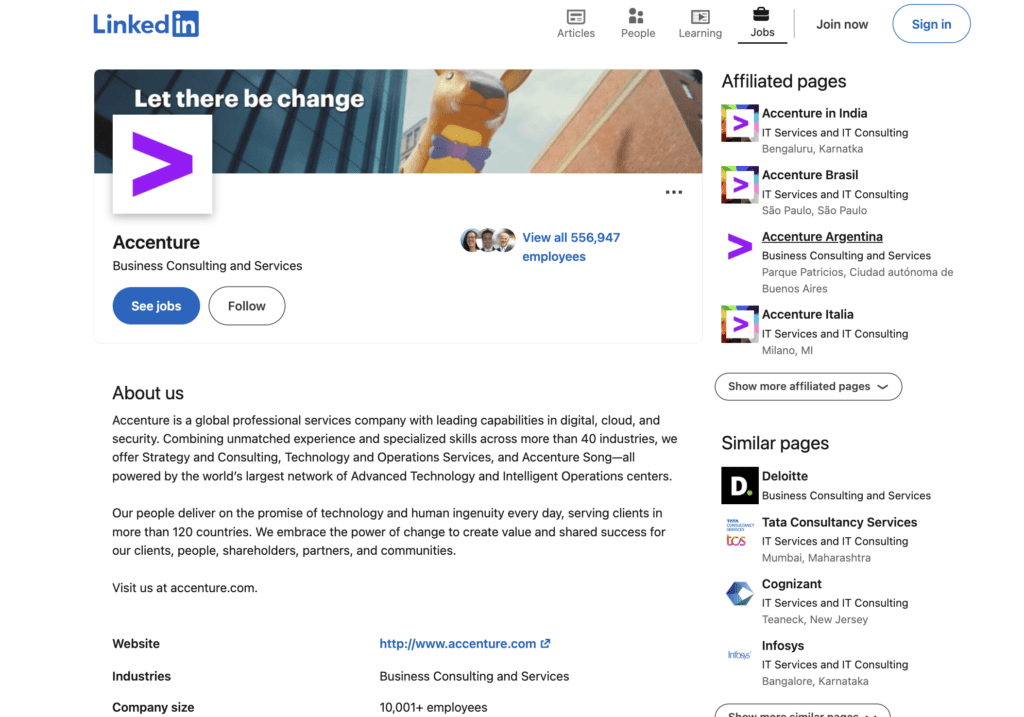
- Measure and Optimize Your Employer Branding Efforts:
Employer branding is an ongoing process, and it’s essential to measure the impact of your efforts.
Use LinkedIn’s analytics tools to track the performance of your posts, engagement rates, and follower growth.
In conclusion, building a strong employer brand on LinkedIn requires a thoughtful and proactive approach. By being authentic, engaging with your community, showcasing employee experiences, and promoting career growth opportunities, you can position your company as an employer of choice.
Remember, consistency and transparency are key to creating a lasting and positive impression on potential candidates.
With LinkedIn’s powerful platform and your dedication to fostering a compelling employer brand, you can attract top talent and propel your organization to greater heights in the competitive job market.
5. Proactively Sourcing Candidates on LinkedIn
In the quest to find the best candidates for your organization, proactive candidate sourcing on LinkedIn emerges as a potent strategy.
Instead of waiting for candidates to come to you, proactively reaching out to potential candidates can significantly expand your talent pool and increase the likelihood of finding the perfect fit for your open positions.
In this section, we will explore the art of proactive candidate sourcing on LinkedIn, supported by relevant examples and data-driven insights.
- Tapping into LinkedIn Groups and Communities:
LinkedIn Groups provide a valuable opportunity to connect with professionals who share common interests, industries, or skill sets.
Join relevant LinkedIn Groups in your industry and actively engage in discussions to build relationships with potential candidates.
Example: If you’re looking to hire a Marketing Manager in the tech industry, join marketing and tech-related LinkedIn Groups. Participate in discussions, offer valuable insights, and foster connections with professionals who exhibit the desired expertise and passion.
- Participating in Talent Pools and Networking Events:
LinkedIn’s vast network of talent pools and networking events can be a goldmine for proactive candidate sourcing.
Example: Keep an eye on LinkedIn’s events section for virtual and in-person networking events, job fairs, and industry conferences. These gatherings offer an excellent opportunity to interact with potential candidates actively seeking new career opportunities.
- Utilizing LinkedIn Recruiter for Advanced Candidate Sourcing:
LinkedIn Recruiter is a premium tool that grants you access to an expanded talent pool and additional search filters, making it an indispensable asset for proactive candidate sourcing.
According to LinkedIn, recruiters using LinkedIn Recruiter have experienced a reduction in time-to-hire.
Example: With LinkedIn Recruiter, you can perform complex searches, save valuable candidates for future reference, and send personalized InMail messages to build connections with potential hires.
- Leveraging Employee Referrals:
Employee referrals are a powerful source of high-quality candidates.
Example: Encourage your current employees to actively participate in the candidate sourcing process by promoting referral programs. Offer incentives for successful referrals, such as bonuses, gift cards, or recognition, to motivate employees to recommend suitable candidates from their networks.
- Engaging in Candidate Outreach:
Proactive candidate sourcing involves personalized outreach to potential candidates who align with your job requirements.
LinkedIn’s InMail feature enables you to send personalized messages to individuals outside your network, increasing your chances of getting a response.
Example: When reaching out to candidates, focus on their unique skills, accomplishments, and interests to demonstrate that you’ve taken the time to understand their background and career aspirations. Highlight how their expertise would be a valuable addition to your organization.
- Building Long-Term Talent Pipelines:
An essential aspect of proactive candidate sourcing is building and maintaining talent pipelines.
According to LinkedIn, 87% of candidates are open to hearing about job opportunities, even if they aren’t actively seeking a new role.
Example: Create segmented talent pipelines based on job functions, skills, and interests. Regularly engage with potential candidates by sharing relevant content, industry updates, and job opportunities. This way, when a relevant position becomes available, you already have a pool of qualified candidates at your fingertips.
- Emphasizing Employer Branding and Company Culture:
A strong employer brand can attract passive candidates who may not actively be seeking new job opportunities.
According to LinkedIn, companies with a strong employer brand experience a 43% decrease in cost-per-hire.
Example: Focus on showcasing your company’s culture, values, and employee experiences through compelling LinkedIn posts and articles. When candidates see your company as an attractive place to work, they may proactively express interest in joining your team.
Read more on these following articles on how to boost your Employer Branding:
- Building a Magnetic Employer Brand: Showcasing Your Company’s Unique Selling Points
- A Comprehensive Guide to Optimizing Your Employer Branding on Your LinkedIn Page
- 5 Essential Strategies for Building a Strong Employer Brand
In conclusion, proactive candidate sourcing on LinkedIn requires a proactive and strategic approach.
By tapping into LinkedIn Groups, participating in networking events, utilizing LinkedIn Recruiter, leveraging employee referrals, engaging in personalized candidate outreach, and building talent pipelines, you can access a vast pool of potential candidates and position your organization as an employer of choice.
Remember, consistency and genuine interest in candidates’ skills and aspirations are essential for establishing lasting relationships and attracting top talent to your organization.
With LinkedIn’s powerful platform and your commitment to proactive candidate sourcing, you can stay ahead in the competitive talent market and secure the best candidates for your team.
6. Nurturing Relationships with Passive Candidates
In the competitive landscape of talent acquisition, proactive recruiters recognize the immense value of nurturing relationships with passive candidates.
Passive candidates are individuals who are currently employed and not actively seeking new job opportunities but could be open to exploring better career prospects if presented with the right opportunity.
According to LinkedIn’s research, approximately 70% of the global workforce falls into the passive candidate category.
Nurturing relationships with these potential candidates can lead to high-quality hires and a competitive advantage in the hiring market.
In this section, we will explore effective strategies for nurturing relationships with passive candidates on LinkedIn, supported by relevant examples and data-driven insights.
- Creating Personalized and Impactful InMail Messages:
LinkedIn’s InMail feature allows recruiters to send direct messages to candidates outside their network. However, crafting personalized and impactful InMail messages is crucial to pique the interest of passive candidates.
Example: Instead of using generic templates, tailor your InMail messages to each candidate’s background and interests. Reference specific accomplishments or skills highlighted in their LinkedIn profiles, and convey how your organization can offer them new and exciting challenges.
- Engaging in Meaningful Conversations and Follow-Ups:
Establishing meaningful conversations and follow-ups with passive candidates can help build rapport and trust over time. It demonstrates your genuine interest in their career aspirations and sets the foundation for a lasting relationship.
Example: Engage with passive candidates by commenting on their posts, congratulating them on professional milestones, and offering relevant industry insights. Regularly check in with them to stay updated on their career journey and showcase your commitment to their success.
- Utilizing LinkedIn’s Talent Insights for Targeted Outreach:
LinkedIn’s Talent Insights provides valuable data and analytics that can help you identify and target passive candidates with precision. You can use these insights to understand their preferences, career trajectories, and the skills they possess.
Example: Suppose you’re targeting passive candidates for a senior leadership role in the technology sector. LinkedIn’s Talent Insights can help you identify professionals with the desired experience and skills, allowing you to tailor your outreach effectively.
- Showcasing Career Growth and Advancement Opportunities:
Passive candidates are more likely to consider a job change if it offers clear opportunities for career growth and advancement. Leverage your LinkedIn Company Page and posts to showcase your organization’s commitment to employee development.
Example: Share stories of employees who have progressed within your company, emphasizing how your organization fosters a culture of continuous learning and advancement. This showcases your commitment to nurturing talent and can be appealing to passive candidates seeking growth opportunities.
- Providing Insider Insights through Employee Testimonials:
Employee testimonials are a powerful way to provide passive candidates with authentic insights into your company culture and work environment. According to LinkedIn, employee advocacy can drive a 5x increase in engagement.
Example: Encourage your current employees to share their experiences working at your organization through LinkedIn posts or articles. When potential candidates see positive feedback from your employees, they are more likely to view your company as an attractive employer.
- Building Talent Communities:
Consider creating talent communities on LinkedIn to engage with passive candidates over the long term. Talent communities provide a platform for sharing valuable content and job opportunities while nurturing relationships with potential candidates.
Example: HubSpot’s LinkedIn Talent Community is an excellent example of building a network of potential candidates interested in marketing, sales, and tech roles. By joining this community, passive candidates can stay informed about the latest job openings and company updates.
- Fostering Relationships through Virtual Events:
Virtual events, such as webinars, panel discussions, and networking sessions, offer an opportunity to engage with passive candidates in a more relaxed and informative setting. According to LinkedIn, 46% of job seekers consider company culture to be crucial when considering job opportunities.
Example: Host virtual events that provide valuable insights into your company culture, industry trends, and professional development opportunities. Invite passive candidates to participate and foster meaningful connections during the event.
In conclusion, nurturing relationships with passive candidates on LinkedIn is a valuable and strategic approach to attracting top talent.
By crafting personalized InMail messages, engaging in meaningful conversations, utilizing LinkedIn’s Talent Insights, showcasing career growth opportunities, providing insider insights through employee testimonials, building talent communities, and hosting virtual events, you can build strong connections with passive candidates.
Remember, the key is to be genuine, transparent, and patient in your approach to cultivating relationships with potential candidates.
With LinkedIn’s powerful platform and your commitment to nurturing passive candidates, you can transform potential prospects into enthusiastic applicants, ultimately leading to successful hires and a stronger talent pipeline for your organization.
7. Showcasing Your Company’s Growth and Success
Demonstrating your company’s growth and success is a powerful way to build credibility, attract top talent, and establish your organization as a leader in your industry.
In today’s competitive business landscape, potential candidates seek employers with a track record of accomplishments and a promising trajectory.
By effectively showcasing your company’s growth and success on platforms like LinkedIn, you can create a compelling employer brand that resonates with job seekers and industry professionals alike.
In this section, we will explore strategies for showcasing your company’s growth and success on LinkedIn, complemented by relevant examples and data-driven insights.
- Share Milestones and Achievements:
One effective method to showcase your company’s growth is by sharing notable milestones and achievements on your LinkedIn Company Page. Celebrate accomplishments such as hitting revenue targets, winning industry awards, or expanding into new markets.
Celebrating such achievements demonstrates the company’s growth trajectory and inspires confidence in potential candidates.
- Highlight Customer Success Stories:
Customer success stories are powerful tools for showcasing your company’s impact and success in the market. Share case studies and testimonials from satisfied customers to illustrate how your products or services have made a difference.
Example: Adobe’s LinkedIn page regularly features customer success stories from various industries, highlighting the tangible benefits their solutions bring to businesses worldwide. Such stories demonstrate the company’s ability to deliver value and drive growth.
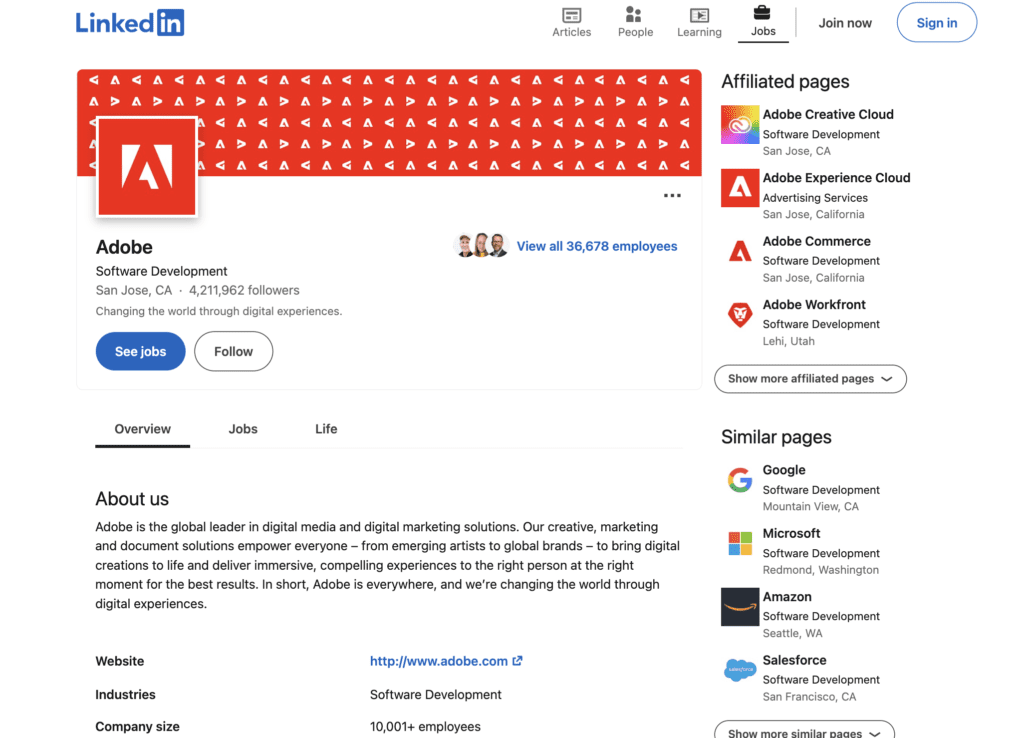
- Showcase Industry Recognition and Awards:
If your company has received industry recognition or awards, don’t hesitate to share the news on your LinkedIn Company Page. This helps build trust and positions your organization as a reputable player in your field.
Example: Microsoft’s LinkedIn page frequently shares news about the company’s achievements, including awards and recognition in various categories. By showcasing these accolades, Microsoft enhances its reputation and attractiveness as an employer.
- Demonstrate Employee Growth and Development:
Highlighting employee growth and development not only showcases your company’s success but also emphasizes your commitment to fostering talent. Share stories of employees who have progressed within the organization and attained new heights.
Example: General Electric (GE) showcases employee success stories on its LinkedIn page, detailing their journey within the company and the opportunities for growth they have experienced. This demonstrates GE’s dedication to nurturing its talent and fostering a culture of advancement.
- Share Thought Leadership Content:
Position your company as a thought leader in your industry by sharing insightful and valuable content on your LinkedIn page. Publish articles, blog posts, and industry reports to showcase your expertise and drive engagement.
Example: IBM’s LinkedIn page regularly publishes thought leadership articles covering diverse topics, such as AI, cloud computing, and sustainability. This positions IBM as an industry leader and attracts candidates seeking to work with innovative and forward-thinking companies.
- Highlight Diversity and Inclusion Initiatives:
Showcasing your company’s commitment to diversity and inclusion is crucial in attracting top talent from diverse backgrounds. Share stories and initiatives that demonstrate your efforts to create an inclusive work environment.
Example: Cisco actively promotes its diversity and inclusion initiatives on its LinkedIn page, including Employee Resource Group (ERG) activities and leadership programs. This sends a strong message about Cisco’s commitment to diversity and its positive company culture.
- Share Employee Testimonials and Experiences:
Authenticity is key to showcasing your company’s growth and success. Encourage employees to share their experiences and perspectives on working at your organization, providing potential candidates with genuine insights.
Example: HubSpot features employee testimonials and stories on its LinkedIn page, offering a glimpse into the company’s vibrant culture and opportunities for personal and professional growth. These testimonials humanize the brand and create a connection with potential candidates.
Showcasing your company’s growth and success on LinkedIn is essential for attracting top talent and establishing your employer brand as a compelling choice for job seekers.
By sharing milestones and achievements, highlighting customer success stories, showcasing industry recognition and awards, demonstrating employee growth and development, sharing thought leadership content, promoting diversity and inclusion initiatives, and featuring employee testimonials, you can build a robust employer brand that resonates with a diverse talent pool.
Remember, authenticity and consistency are key to creating a lasting impression on potential candidates and positioning your organization as a thriving and desirable workplace.
With LinkedIn’s powerful platform and your commitment to showcasing your company’s growth and success, you can attract high-caliber candidates and strengthen your position as a leader in your industry.
8. Measuring Success: Key Metrics for LinkedIn Hiring Campaigns
LinkedIn’s vast professional network offers a powerful platform for recruiting top talent, and measuring the success of your hiring campaigns is essential to optimizing your recruitment efforts.
By tracking and analyzing key metrics, you can gain valuable insights into the performance of your LinkedIn hiring campaigns and make data-driven decisions to attract the best candidates.
In this section, we will explore the key metrics to measure the success of LinkedIn hiring campaigns, accompanied by relevant examples and data-backed insights.
- Click-Through Rate (CTR):
Click-through rate (CTR) is a crucial metric that measures the percentage of people who click on your job posts or recruitment ads after viewing them.
A high CTR indicates that your content is engaging and resonates with your target audience.
Example: Suppose you ran two LinkedIn job posts with different headlines. Post A received 500 views and 25 clicks, while Post B received 500 views and 50 clicks. Post B has a higher CTR (10%) compared to Post A (5%), indicating that its headline was more compelling and attracted more interest from potential candidates.
- Application Rate:
The application rate measures the percentage of candidates who submitted their applications after clicking on your job posts or recruitment ads.
It helps assess the effectiveness of your job descriptions and the level of interest your opportunities generate.
Example: If your job post received 100 clicks and 10 candidates applied, the application rate is 10%. A high application rate indicates that your job post effectively communicates the role’s requirements and perks, compelling candidates to take action.
Do note for free job postings, LinkedIn limits the number of candidates that apply to your job to less than 60. Try using 9cv9 free job postings which has an unlimited number of applications.
- Conversion Rate:
The conversion rate calculates the percentage of candidates who completed the desired action, such as submitting an application or signing up for your talent community, out of the total number of people who viewed your recruitment content.
Example: If your LinkedIn recruitment ad received 1,000 views and resulted in 50 applications, the conversion rate is 5%. A higher conversion rate indicates that your recruitment content and call-to-action (CTA) are effective in motivating candidates to take the desired action.
- Cost-Per-Click (CPC) and Cost-Per-Lead (CPL):
Cost-per-click (CPC) measures the cost of each click on your job post or recruitment ad, while cost-per-lead (CPL) calculates the cost of acquiring a potential candidate’s information (e.g., through lead generation forms).
Example: If you spent $200 on a LinkedIn recruitment ad that received 400 clicks, the CPC is $0.50 ($200 / 400 clicks). If 20 of those clicks resulted in candidates submitting their information, the CPL is $10 ($200 / 20 leads).
- Quality of Applicants:
Measuring the quality of applicants is crucial to assess the effectiveness of your LinkedIn hiring campaigns. It involves evaluating the relevance of applicants’ skills, experience, and qualifications to the open positions.
Example: If you received 100 applications for a software engineering role and 10 of them were from candidates with extensive experience in the required programming languages and technologies, you can consider those 10 applications as high-quality applicants.
Time-to-fill measures the number of days it takes to fill a job vacancy from the moment it is opened to the candidate’s acceptance of the offer. Reducing time-to-fill is essential to securing top talent quickly and minimizing the impact of unfilled positions on business operations.
Example: If it took your company 45 days to fill a marketing manager position after posting it on LinkedIn, the time-to-fill for that role is 45 days.
- Source of Hires:
Tracking the source of hires helps identify which platforms or channels are most effective in delivering qualified candidates. LinkedIn provides insights into the number of hires originating from your LinkedIn hiring campaigns.
Example: If you hired five candidates through LinkedIn campaigns and three through other channels, LinkedIn’s source of hires contributed to 62.5% (5 out of 8) of your total hires.
- Candidate Demographics and Diversity:
Analyzing the demographics and diversity of your candidate pool is crucial for ensuring inclusive hiring practices. LinkedIn offers insights into candidate demographics, allowing you to assess the representation of underrepresented groups.
Example: By examining LinkedIn’s demographic data, you can determine if your candidate pool includes individuals from diverse backgrounds and take steps to improve diversity and inclusion in your hiring process.
Measuring the success of your LinkedIn hiring campaigns is vital for optimizing your recruitment efforts and attracting top talent.
By tracking key metrics such as click-through rate (CTR), application rate, conversion rate, cost-per-click (CPC), cost-per-lead (CPL), quality of applicants, time-to-fill, source of hires, and candidate demographics and diversity, you can gain valuable insights into the effectiveness of your recruitment strategies.
These insights enable data-driven decision-making, ensuring you can refine your hiring campaigns to attract and secure the best candidates for your organization.
With LinkedIn’s powerful analytics tools and your commitment to continuous improvement, you can elevate your recruitment efforts and build a talented and diverse workforce to drive your company’s success.
9. Overcoming Challenges and Best Practices for LinkedIn Hiring
LinkedIn has emerged as a leading platform for talent acquisition, offering recruiters and hiring managers a vast pool of potential candidates.
However, like any recruitment strategy, LinkedIn hiring comes with its own set of challenges.
In this section, we will explore the common challenges faced in LinkedIn hiring and provide best practices supported by relevant examples and data-backed insights.
- Challenge: High Competition for Top Talent
As LinkedIn attracts millions of recruiters and hiring managers worldwide, the competition for top talent can be fierce.
This makes it challenging to stand out and capture the attention of high-caliber candidates.
Best Practice: Develop a compelling employer brand that showcases your company’s unique culture, values, and opportunities for growth.
Highlighting your organization’s success stories, employee testimonials, and industry recognition can attract passive candidates and make you an employer of choice.
Example: Google’s LinkedIn page effectively demonstrates its employer brand by sharing stories of employee experiences, innovative projects, and community initiatives. By portraying Google as an industry leader and an inclusive workplace, they attract top talent from various industries.
- Challenge: Finding Niche and Technical Skills
Some roles require niche or technical skills that may be challenging to find through traditional job postings.
Identifying candidates with the precise skill set can be time-consuming.
Best Practice: Utilize LinkedIn’s advanced search filters and Boolean search operators to narrow down your candidate search. Join LinkedIn Groups and communities related to the specific industry or skill you’re seeking to find potential candidates with the expertise you need.
Example: If you’re seeking candidates with expertise in Artificial Intelligence (AI), joining AI-related LinkedIn Groups can help you connect with professionals knowledgeable in the field.
- Challenge: Passive Candidate Engagement
Reaching out to passive candidates, who are not actively seeking new job opportunities, can be tricky.
Convincing them to consider your job openings requires personalized and strategic communication.
Best Practice: Craft personalized and compelling InMail messages that highlight the value of your opportunity to passive candidates. Focus on how your organization can contribute to their career growth and offer challenging projects.
Example: Suppose you’re seeking a senior developer with expertise in Blockchain technology. Your InMail could discuss exciting projects related to Blockchain development and how the candidate’s skills align perfectly with your company’s vision.
- Challenge: Measuring ROI and Performance
Evaluating the success of LinkedIn hiring campaigns and calculating their return on investment (ROI) can be complex without proper tracking and measurement.
Best Practice: Use LinkedIn’s analytics tools to measure key performance metrics, such as click-through rate (CTR), application rate, conversion rate, and source of hires. Analyzing these metrics will help you understand the effectiveness of your campaigns and optimize your recruitment strategies.
Example: By tracking the CTR of your LinkedIn job posts, you can assess which posts attract more clicks, enabling you to refine your content and improve candidate engagement.
- Challenge: Ensuring Diversity and Inclusion
Creating a diverse and inclusive workforce is essential for innovation and better decision-making. However, unconscious biases may inadvertently impact hiring decisions.
Best Practice: Establish standardized hiring criteria and processes to reduce biases and ensure a fair and inclusive hiring process. Encourage diversity by actively sourcing candidates from diverse backgrounds and promoting diversity initiatives.
- Challenge: Managing a High Volume of Applications
When your LinkedIn hiring campaigns are successful, managing a large volume of applications can become overwhelming, leading to delayed responses and potential candidate dissatisfaction.
Best Practice: Utilize applicant tracking systems (ATS) to streamline and organize your recruitment process. ATS can help you manage applications efficiently, track candidate progress, and communicate effectively with applicants.
- Challenge: Time-Consuming Candidate Screening
Screening a large number of applications to identify the best-fit candidates can be time-consuming and resource-intensive.
Best Practice: Implement pre-screening questionnaires or assessments to quickly identify candidates who possess the essential qualifications and skills for the role. Automated candidate screening tools can also help streamline the process.
Example: Intel uses pre-screening assessments to evaluate technical skills and cultural fit, saving time and ensuring only qualified candidates move forward in the hiring process.
LinkedIn hiring offers an array of opportunities for connecting with top talent, but it also presents various challenges.
By adopting best practices such as developing a compelling employer brand, utilizing advanced search filters, crafting personalized InMail messages, measuring campaign performance, promoting diversity and inclusion, using ATS, and implementing pre-screening assessments, you can overcome these challenges and optimize your LinkedIn hiring efforts.
Remember, data-driven strategies and thoughtful candidate engagement are essential for attracting the best candidates and building a talented and diverse workforce that drives your company’s success.
With LinkedIn’s robust platform and your commitment to continuous improvement, you can navigate the challenges of LinkedIn hiring and successfully secure top talent for your organization.
Conclusion
In the ever-evolving landscape of talent acquisition, LinkedIn stands as a beacon of opportunity for forward-thinking recruiters and hiring managers seeking to attract top talent to their organizations.
Throughout this comprehensive guide, we have delved into the art of hiring top talent using LinkedIn, exploring a multitude of strategies, tips, and best practices to optimize your recruitment efforts on this powerful platform.
LinkedIn offers a treasure trove of features and tools designed to empower recruiters to connect with professionals across industries and continents, but harnessing its full potential requires a strategic and thoughtful approach.
As you embark on your journey to source, engage, and hire top talent through LinkedIn, remember these key takeaways:
- Cultivate an Authentic Employer Brand: Your employer brand serves as the foundation for attracting and retaining exceptional talent. Showcase your company’s unique culture, values, and success stories through compelling content and employee testimonials. Emphasize your organization’s commitment to employee growth and development to resonate with ambitious candidates.
- Embrace Proactive Candidate Sourcing: Waiting for candidates to come to you may not suffice in today’s competitive job market. Actively engage in proactive candidate sourcing by utilizing LinkedIn’s advanced search filters, joining industry-specific groups, and leveraging LinkedIn Recruiter. Reach out to potential candidates with personalized and impactful InMail messages, highlighting how your company can be the catalyst for their career advancement.
- Craft Irresistible Job Posts: Your job posts are the gateways to attracting the right candidates. Craft attention-grabbing job titles, concise yet compelling descriptions, and showcase the unique opportunities your organization offers. Use data and insights from LinkedIn’s Talent Insights to tailor your job posts to the preferences and skills of your target audience.
- Optimize LinkedIn’s Search and Filtering Tools: LinkedIn’s powerful search and filtering capabilities can streamline your candidate search. Utilize Boolean search operators and Talent Insights to identify and connect with candidates possessing the niche and technical skills required for specialized roles.
- Build a Strong Employer Brand: A robust employer brand helps you stand out in a sea of competition. Use LinkedIn to showcase your company’s growth, success, and industry recognition. Highlight employee achievements, share customer success stories, and present thought leadership content to position your organization as an industry leader.
- Nurture Relationships with Passive Candidates: Engaging passive candidates requires patience and personalized communication. Foster meaningful connections through consistent interactions, thoughtful InMail messages, and authentic engagement with your LinkedIn community. Utilize talent communities and virtual events to build rapport with potential candidates over time.
- Measure Success with Data-Driven Insights: Track and analyze key metrics to measure the success of your LinkedIn hiring campaigns. Monitor click-through rates, application rates, conversion rates, and the source of hires to gauge the effectiveness of your recruitment efforts. Utilize applicant tracking systems and pre-screening assessments to manage high application volumes efficiently.
By combining these strategies, you can unlock the full potential of LinkedIn for top talent acquisition.
Keep in mind that hiring is an iterative process, and continuous improvement is essential to staying ahead in the competitive talent landscape.
As you embark on your LinkedIn hiring journey, remember that fostering meaningful relationships with candidates and providing an exceptional candidate experience are paramount.
Be genuine, transparent, and responsive in your interactions, and focus on aligning your hiring efforts with your company’s long-term goals and values.
The power of LinkedIn as a talent acquisition tool is virtually limitless, offering you the ability to connect with top talent globally, shape your company’s reputation, and build a workforce that propels your organization to new heights of success.
So, take the plunge into the world of LinkedIn hiring, armed with the knowledge and strategies outlined in this guide.
Embrace the opportunities, navigate the challenges, and watch as your organization thrives with the addition of top-tier talent sourced from the world’s largest professional network.
Now, go forth, embrace the possibilities, and unlock the potential of LinkedIn to hire the brightest minds that will propel your organization towards a future of innovation and success. Happy hiring.
If your company needs HR, hiring, or corporate services, you can use 9cv9 hiring and recruitment services. Book a consultation slot here, or send over an email to [email protected].
If you find this article useful, why not share it with your hiring manager and C-level suite friends and also leave a nice comment below?
We, at the 9cv9 Research Team, strive to bring the latest and most meaningful data, guides, and statistics to your doorstep.
To get access to top-quality guides, click over to 9cv9 Blog.
People Also Ask
How do you attract top talents on LinkedIn?
To attract top talents on LinkedIn, create a compelling employer brand showcasing your company’s culture, growth opportunities, and success stories. Utilize advanced search filters, personalized InMail messages, and proactive candidate sourcing strategies to engage with potential candidates. Regularly share thought leadership content, participate in relevant industry groups, and highlight your commitment to diversity and inclusion to stand out and appeal to top-tier professionals.
How can I use LinkedIn to recruit?
Utilize LinkedIn to recruit by optimizing your Company Page with compelling content, showcasing your employer brand, and posting job openings. Leverage LinkedIn’s advanced search filters to find and connect with potential candidates. Engage in proactive candidate sourcing, participate in relevant groups, and utilize InMail messages for personalized outreach. Regularly analyze performance metrics to refine your recruitment strategy and attract top talent effectively.
How do you attract and retain top talent?
To attract and retain top talent, prioritize creating an inclusive and positive work culture. Offer competitive compensation, growth opportunities, and work-life balance. Provide professional development, recognize achievements, and foster open communication. Listen to employee feedback and implement initiatives that demonstrate a commitment to employee well-being and career progression.































![Writing A Good CV [6 Tips To Improve Your CV] 6 Tips To Improve Your CV](https://blog.9cv9.com/wp-content/uploads/2020/06/2020-06-02-2-100x70.png)


